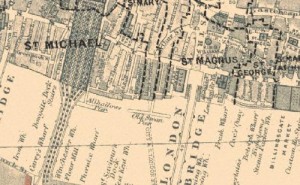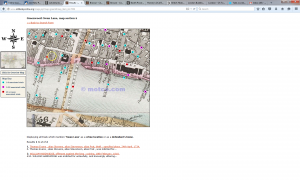Swan Lane, or ‘Upper Swandam Lane’ is a street featured in the Adventures of Sherlock Holmes short story titled “The Man with the Twisted Lip”. It is the street where the infamous opium den – “Bar of Gold” is located. Mrs. St. Clair went to pick up a package on Fresno Street when she stumbled upon Upper Swandam Lane on her way back home from running errands, and “she did not like the neighborhood in which she found herself.” Clearly there are no noble deeds or productive work being done in this kind of an area.
One interesting fact I would like to point out about this area is that the poverty classification for the time period of 1898-9 (ten years after Twisted Lip took place in 1889) was considered “poor”. In the story, the den was even located “between a slop-shop and a gin-shop”. A slop-shop is defined as ‘a store in which cheap, ready-made clothing may be purchased.’ I recall earlier in the semester that the rise of ready-made clothing made clothes cheaper and could disguise a person’s class better since anyone could buy the same clothes from a department store. And the latter, a gin-shop is obviously where one can purchase alcohol (opium and alcohol – probably not the best mix!). 
Another interesting fact is that on the Charles Booth Poverty map, there is not much indicator of class in the area of Swan Lane. Where there is color, though, it is light blue, meaning “poor”. Our professor actually pointed out to me that the reason for the absence of classification for a good portion of the area is that there might’ve been factories there. I do know that the ‘wharves’ near it (mentioned in the story) were for vessels to lie at rest, and to load or unload on piers. London OS Town Plan shows ‘Old Swan Pier’ directly south of it in the river.
To my surprise,when I was looking up crimes on the Old Bailey website there wasn’t much to find. Swan Lane (during the period of 1674 to 1834) only had 2 associated trials (one was a theft, the other a ‘royal offense’ – more specifically, coining offense – neither one indicated violence). However, it is located next to a high-crime area, George Alley, which was associated with ’23 or more’ trials. In the story there was actually mention of an alley. Mr. Watson said “Upper Swandam Lane is a vile alley lurking behind the high wharves…” There is no mention of George Alley, however. Maybe Swan Lane had more of a reputation for crime in the year 1889, or maybe Sir Arthur Conan Doyle just chose this location to spice things up in London. He might’ve met to associate the probably-infamous George Alley with the nearby Swan Lane.
I do think, however, that Doyle made a bit of a slip-up in where Swan Lane is located. In the story, Watson says that Swan Lane lines “the north side of the river to the east of the London Bridge.” While Swan Lane does lie north of the river, it is actually to the west of the London Bridge, which I have seen reflected on several different maps.
Another street mentioned in the story is Fresno Street, where Mrs. St. Clair picked up a package nearby. The story indicates that it was walking distance away from Swan Lane, but I have searched both maps and there is no Fresno Street. Maybe Doyle wanted to create a nice area nearby where she would have been running her errands but have been close enough to stumble into a rough neighborhood. But since much of the real area was poor, I don’t believe such a place actually existed.
Upper Swandam Lane is a central location to the story in regards to the plot and theme. There are themes of class and crime in this story. Holmes even refers to the den as a “murder trap” and says that many people have died in that den (page 131). Both Watson and Holmes’ sentiments toward that particular street are negative. And for the plot, Swan Lane is where Neville St. Clair goes in as a well-dressed man and is able to come out in disguise as a beggar every single day as he pretends to go to work. It is also where his wife sees him looking out of the window of the den, and where Isa Whitney is found completely belligerent off of opium in a room full of men under the same influence. It is a very sketchy area to say the least, and a sad picture of addiction.
Sources:
Adventures of Sherlock Holmes – The Man with the Twisted Lip
Booth Poverty Map and Modern Map
Place and Map Search for Swan Lane Old Bailey
-Miranda Delancey



















